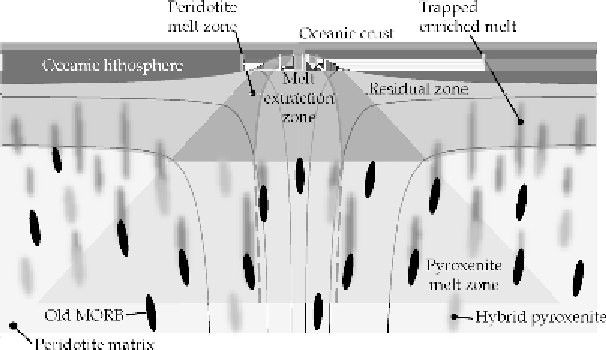Geology Reference
In-Depth Information
Figure 10.14. Sketch of melting under a mid-ocean ridge for a heterogeneous
source. Old subducted oceanic crust (MORB) in the eclogite assemblage will
start melting at a greater depth than peridotite. Some of the resulting melt may
fail to be extracted, and remain as hybrid pyroxenite. Multiple generations of
hybrid pyroxenite may return to the melting zone. After Davies [118]. Copyright
American Geophysical Union.
An implication of this picture is that substantial amounts of hybrid pyroxenite
will be recirculated within the mantle. Over time some of it will return to MORB
melting zones, potentially to be remelted. Thus there will be multiple generations
of hybrid pyroxenite, and a significant population of it will accumulate, as fore-
shadowed in Section 10.4.4. The material entering melting zones will have three
main components, not two: peridotite residue, subducted oceanic crust and hybrid
pyroxenite. Incompatible elements will be carried by both the subducted oceanic
crust and the hybrid pyroxenite. The two types of heterogeneous inclusion are
depicted in Figure 10.14.
10.6 Previous estimates of trace element abundance
The abundance of uranium and, by implication, other incompatible trace elements
found in Section 10.2 is more than twice that of previous estimates. Several reasons
can be found for why the previous estimates are too low, some relating directly to
heterogeneity, others not.
10.6.1 Sampling heterogeneity, not mixing reservoirs
The Nd-Sr isotopic array in Figure 10.2(c) was initially interpreted as a mixing
line between compositions of two reservoirs, a strongly depleted upper mantle and

